Hualin Temple (Fuzhou)
Hualin Temple (simplified Chinese: 华林寺; traditional Chinese: 華林寺; pinyin: Huálín Sì) is a Buddhist temple located in Gulou District, Fuzhou, Fujian. After the introduction of Chan Buddhism from China to Japan in the Song dynasty (960–1279), the architectural style of Song dynasty have a profound influence on Japan traditional cultural and folk customs.[1] [2] The oldest things in the temple is the Main Hall, which was built in the early Song dynasty (960–1279).[1][3]
| Hualin Temple | |
|---|---|
华林寺 | |
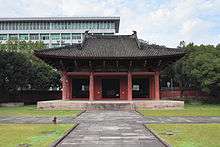 Main Hall at Hualin Temple. | |
| Religion | |
| Affiliation | Buddhism |
| Deity | Chan Buddhism |
| Location | |
| Location | Gulou District, Fuzhou, Fujian |
| Country | China |
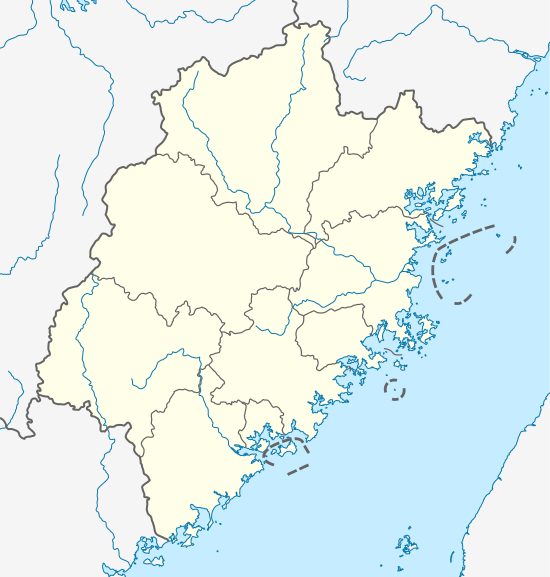 Shown within Fujian | |
| Geographic coordinates | 26°06′11.74″N 119°17′31.47″E |
| Architecture | |
| Style | Chinese architecture |
| Date established | 964 |
History
Song dynasty
Hualin Temple was first built with the name of "Yueshan Jixiang Chan Temple" (越山吉祥禅院) in 964 by the then provincial governor of Fuzhou Bao Xiurang (鲍修让), under the kingdom of Wuyue in the Five Dynasties and Ten Kingdoms (907–960).[1][4] During the reign of Emperor Gaozong (1127–1162), he inscribed the name on a plaque to the name.[1] In the Song and Ming dynasties, the temple is renowned for its quiet and beautiful environment, which attracted many literati to come and compose poems to eulogize the temple, including Li Gang, Zhang Jun, Wang Yingshan, and Xie Zhaozhi.[3]
Ming dynasty
In 1444, in the ruling of Emperor Yingzong in the Ming dynasty (1368–1644), the emperor inscribed and honored the name "Hualin Temple" (华林寺), which is still in use now.[1][3]
Qing dynasty
In 1644, the year of the founding of the Qing dynasty (1644–1911), Hualin Temple was renovated by monks. In 1668, in the ruling of Kangxi Emperor (1662–1722), it was refurbished again. The temple became dilapidated due to neglect in the Yongzheng era (1723–1735). It was enlarged in the Jiaqing (1796–1820) and Daoguang periods (1821–1850). Lin Zexu, a notable official in the Qing court, wrote an article about the reconstruction project.[3]
People's Republic of China
After the establishment of the Communist State in 1953, Hualin Temple was designated as a provincial level cultural heritage by the Fujian Provincial Government.[3]
In 1966, Mao Zedong launched the ten-year Cultural Revolution, the Shanmen, Hall of Four Heavenly Kings, corridors and walls were demolished by the Red Guards with only the Main Hall remaining.[3]
On 23 February 1982, the Main Hall of Hualin Temple was listed among the second batch of "Major National Historical and Cultural Sites in Fujian" by the State Council of China.[3] [5]
Hualin Temple was officially reopened to the public in the Chinese New Year of 1990.[3]
Architecture
Main Hall
The Main Hall in the temple has single-eave gable and hip roof covered with black tiles, which represented water then and could extinguish fire. It still preserves the architectural style of the early Song dynasty.[6] The Main Hall is 15.5-metre (51 ft) high, three rooms wide, four rooms deep and covers an area of 574-square-metre (6,180 sq ft). It is rectangular in shape with eight purlins and four pillars.[4][7] It is the earliest wooden architecture in Jiangnan.[1][8][9][10]
Gallery
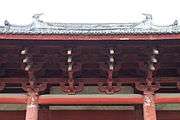 Main Hall.
Main Hall.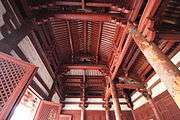 Roof of the Main Hall.
Roof of the Main Hall.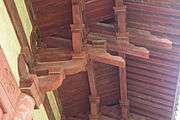
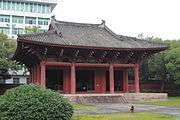 Main Hall.
Main Hall.
References
- Zhang Yuhuan (2012), p. 193.
- Zhang Fan (2010). 论华林寺对日本寺庙建筑的影响. China Business (in Chinese). Beijing. 10. ISSN 1006-7833.
- Codification Committee (1999), p. 512–513.
- "Hualin Temple". Chinadaily. 22 March 2010. Retrieved 28 June 2018.
- 华林寺大殿:隐匿闹市中的木构奇作. fjsen.com (in Chinese). 2016-11-03.
- 福州华林寺大殿隋唐建筑. chinaasc.org (in Chinese). 2007-05-25.
- 华林寺大殿. china.com.cn (in Chinese). 2006-12-04. Retrieved 2020-01-06.
- 福州千年古刹华林寺. Sohu (in Chinese). 2017-01-14. Retrieved 2020-01-06.
- 福州华林寺闭馆大修? 原来是在检测漏水(图). 163.com (in Chinese). 2014-10-14.
- 谦谦君子华林寺. ifeng (in Chinese). 2016-08-31.
Bibliography
- Zhang Yuhuan (2012). "The earliest Wooden Architecture in Jiangnan: Hualin Temple in Fuzhou" 《存有江南最古老的木构建筑:福州华林寺》. 《图解中国著名佛教寺院》 [Illustration of Famous Buddhist Temples in China] (in Chinese). Beijing: Contemporary China Publishing House. ISBN 978-7-5154-0135-5.CS1 maint: ref=harv (link)
- Codification Committee (1999). 《福州市志》 [Fuzhou Annals] (in Chinese). Beijing: Parkstone Press. ISBN 7112019931.CS1 maint: ref=harv (link)